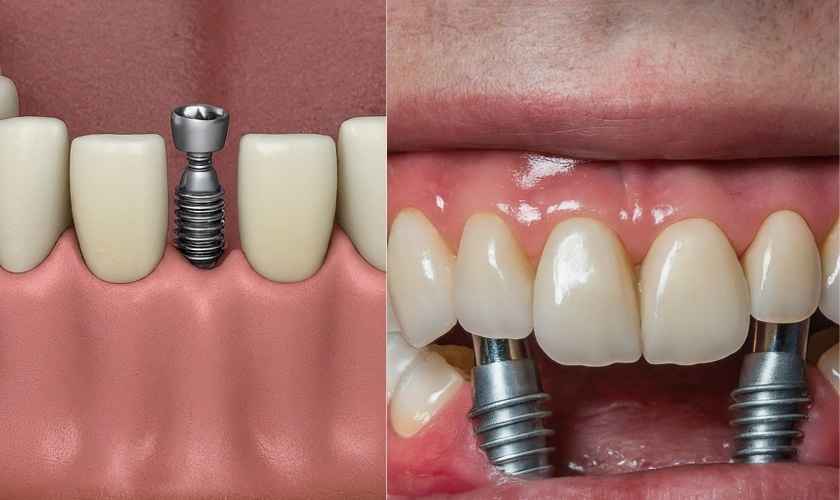The Dental Sense Diaries
Table of ContentsDental Sense Can Be Fun For AnyoneSome Known Factual Statements About Dental Sense The Facts About Dental Sense RevealedSome Ideas on Dental Sense You Should Know
are clinical tools operatively dental implanted into the jaw to bring back a person's capability to eat or their look. They provide assistance for synthetic (phony) teeth, such as crowns, bridges, or dentures. When a tooth is shed due to injury or illness, an individual can experience complications such as rapid bone loss, malfunctioning speech, or adjustments to chewing patterns that result in discomfort.Oral implant systems contain a dental implant body and oral implant joint and might likewise include a joint fixation screw. Dental veneers cost. The oral implant body is operatively placed in the jawbone instead of the tooth's root. The dental implant abutment is generally connected to the implant body by the joint fixation screw and prolongs through gum tissues into the mouth to support the connected synthetic teeth
(https://medium.com/@matthewmusic33101/about)Framework of The Oral Implant System picking dental implants, talk with your oral provider regarding the prospective advantages and risks, and whether you are a candidate for the treatment. Things to think about: Your overall health is an important variable in figuring out whether you are an excellent candidate for oral implants, for how long it will require to recover, and the length of time the dental implant might remain in place.
Smoking cigarettes might influence the recovery process and lower the long-lasting success of the dental implant. The recovery process for the dental implant body might take several months or longer, throughout which time you normally have a momentary abutment instead of the tooth. the dental implant procedure: Thoroughly comply with the dental health directions offered to you by your oral company.
The Only Guide to Dental Sense
Implant failure can cause the requirement for one more procedure to take care of or change the dental implant system. Brings back the ability to eat Restores cosmetic look Helps maintain the jawbone from reducing because of bone loss Maintains the health and wellness of the bordering bone and gums Helps keep surrounding (neighboring) teeth steady Improves lifestyle Damage to surrounding natural teeth throughout dental implant positioning Injury to the surrounding tissues throughout surgical treatment, such as sinus perforation Injury throughout surgical procedure (for instance, crack of bordering jawbone) Insufficient feature, such as seeming like the teeth do not bite together generally A feeling that the tooth hangs or turning in location resulting from a joint screw loosening Implant body failing (looseness of the dental implant body) because of systemic infection, which might be more probable in patients with unrestrained diabetics issues because of neighborhood infection in bone and periodontals supporting the implant body due to postponed healing, which might be most likely in people who smoke Trouble cleansing the gum tissues around the implant, causing inadequate oral hygiene Unattended periodontal disease Post-surgical numbness because of nerve impingement or damage Always alert healthcare service providers and imaging specialists that you have dental implants prior to any type of magnetic resonance imaging (MRI) or x-ray treatments.
FDA is not knowledgeable about any kind of damaging events reported for MRI or x-ray procedures with oral implants. Oral implants systems are normally made of materials that adhere to global consensus criteria of the International Company for Standardization (ISO) or ASTM International. These requirements have information of what makes a risk-free material.

An oral implant is a structure that changes a missing tooth. With screw-like tools, the surgeon inserts a dental implant into the jawbone, and it acts as a support for a fabricated tooth, called a crown. A tool called a joint attaches the synthetic tooth to the oral implant. The crown is personalized to fit the individual's mouth and match the shade of their teeth.
The 4-Minute Rule for Dental Sense
Some people are not eligible for oral implant surgical treatment. It is for oral surgeons to operate on individuals with: severe illnessuncontrollable metabolic diseasebone or soft tissue condition or infectionIf these concerns are resolved, an individual can have the surgical treatment. In, oral surgeons avoid from operating people with: If people with any of the above undergo oral implant surgery, there is a greater risk of the implant falling short.

Oral implant surgical procedure is a personalized process. It's not the exact same for every person. However the adhering to provides a basic review of what you can expect your dental professional, oral cosmetic surgeon, periodontist or prosthodontist to do: Position the dental implant operatively. Offer you time to recover. Affix the blog post and last crown, bridge or denture.
Next off, your cosmetic surgeon will thoroughly put the oral implant right into your jaw. Your doctor will reposition your gums and shut the cut with stitches. If your dental implant is near the front of your mouth, your dental professional will make a short-lived tooth for you to put on till you recover. This way, you won't have a gap in your smile while you recover.
Everything about Dental Sense
Throughout the healing phase, your jawbone should fuse to the oral implant. This process can take anywhere from three to 9 months.
Once your implant heals, your dental professional can connect the abutment (little adapter post) and your final restoration (crown, bridge or denture). This usually takes regarding one hour to complete and might call for a second minor surgery. You shouldn't feel any type of pain during your dental implant treatment because your supplier will use drug to numb your gums.